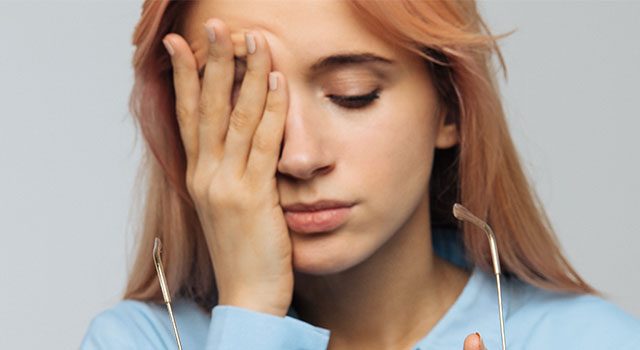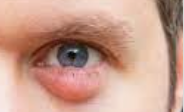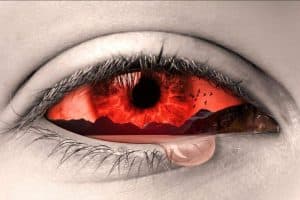Chronic and severe dry eyes can be debilitating. Fortunately, in-office dry eye treatments can get to the root of your symptoms, for longer lasting results.
In many cases, dry eye symptoms can be managed at home with warm compresses, supplements and the right eye drops.
However, when dry eye symptoms persist or worsen, it’s recommended to visit your local eye doctor to receive in-office treatment.
Fortunately, a number of effective in-office options exist. Here are 10 in-office treatments for dry eyes:
1. Steam goggles
For this treatment, a set of goggles is placed on your eyes and warmed via an electronic timing device. These goggles produce steam, which brings moisture to the eyes.
Patients like this treatment, as the goggles are transparent, so you can still look at your phone or read books and magazines while wearing them.
This heating device warms your eyelids, softening the oils in the meibomian glands. Your eye doctor may then massage your eyelids, or open the oil glands, releasing the vital oils into your tears.
This treatment is often used along with other dry eye treatments, but can also be used on its own to treat dry eye symptoms.
2. Eyelid scrub
For this procedure, your eye doctor will use a handheld device to carefully spin a medical-grade sponge at high speeds along the edge of your eyelid.
The scrub will remove biofilm, bacteria and toxins from your eyelids and the glands lining your eyelids.
This treatment can be used on its own or in conjunction with other dry eye treatments, and is used to treat swollen eyelids and meibomian gland blockages.
3. Pulsed heat and massage
For this treatment, your eye doctor will place applicators over the front and back of both eyelids.
Heat and pressure are applied to the applicators to massage the meibomian glands and release the clogged oils.
Numbing eye drops are used before each session, to optimize patient comfort. This treatment has been reported to reduce dry eye symptoms for six months to a year and minimal side effects have been reported.
In order to completely release the oil clogged in the glands, your eyecare provider may gently massage your eyelids after the heat has been applied.
4. LED-based heat and massage
This treatment is best used as-needed, rather than on a regular schedule, and is especially helpful for patients who wear face masks all day, every day, due to COVID-19 regulations.
Your eye doctor will use a portable device that both heats and massages the eyelids, using LED-based heat and gentle pressure-work, simultaneously. As these two work together, clogged oils are freed up, lessening dry eye symptoms.
SEE RELATED: What to Expect at a Dry Eye Exam
Don’t let dry eyes impact your life, schedule an appointment with an eye doctor near you to learn about effective in-office treatments.
5. Heat pads and eyelid massage
This treatment includes a wired handpiece and metal eye pads that are placed over the eyelids. Each piece is connected to a console that provides heat to the eyelids.
While the heat is being applied, your eye doctor will manually massage the pads over your eyelids.
This will release any blockages you may have in your meibomian glands. This device may require more frequent treatments than some of the others on this list.
6. Punctal plugs
Your eye doctor will insert tiny plugs made of silicone or collagen into the small openings on the lower lid where tears drain out of the eye. This area is called the punctum. These plugs may be dissolvable or they may be removed periodically and reinserted when needed.
Inserting punctal plugs is meant to address issues with a shortage of water in a patient’s tears, as they hold the tears in the eye.
Insertion is quick and painless, creating a blockage that causes tears to drain less quickly. This leaves more tear film available to keep the surface of your eyes comfortably moisturized.
Punctal plugs can even reduce inflammation caused by dry eye syndrome. Once inserted, punctal plugs generally do not cause any discomfort.
7. Intense pulsed light therapy (IPL)
Intense FDA-approved pulsed light therapy (IPL) is used for a number of purposes, including removal of skin lesions, and treatment for rosacea and other skin conditions.
Eye doctors have also used IPL to treat meibomian gland blockages as well to reduce ocular inflammation and bacterial colonies that result in dry eyes.
During an IPL session, your eye doctor will apply infrared light directly to the eyelids with a handheld device. This light wavelength can reduce inflammation and loosen meibomian gland blockages.
8. Amniotic tissue treatment
Studies have shown that this treatment is so effective that it can keep severely dry eyes comfortable for months after removal of the special lenses involved.
Patients have likened this to the feeling of wearing a soothing contact lens in their eye.
Using a piece of donated amniotic tissue, a lens is created and then held in place over the cornea with a small ring. Cells from a placenta have a great deal of regenerative and healing power, so using these cells in this lens helps to heal the patient’s cornea.
Lenses for this treatment are usually worn for three days.
9. Silicone eyelid scrub and daily cleanser
This treatment is both quick and convenient, taking only about one minute a day to do.
For patients who find sitting in their eye doctor’s office inconvenient or otherwise not an option, a handheld system that can be taken home may be recommended. This machine massages and cleans the eyelids with a disposable soft silicone tip.
It is important to supplement this treatment with a daily cleanser.
10. Electric-pulse tear production
This treatment is mainly used for patients that suffer with a specific type of meibomian gland dysfunction known as “aqueous deficient.” Unlike many other treatments, this treatment is done through the nose rather than the eyes.
Your eye doctor will insert a tiny probe into each nostril, which will deliver small electrical currents to the nerves lining the inside of your nose.
The electrical pulses will stimulate the nerves, telling the brain that it needs to increase tear production. Because it involves electrical currents, this treatment is not meant for patients who have pacemakers or defibrillators.
LEARN MORE: Guide to Dry Eye
If dry eyes are impacting your life, schedule an appointment with an eye doctor near you to discuss which in-office treatments are the most effective for you.
When dry eye symptoms persist or worsen, it’s recommended to visit your local eye doctor to receive in-office treatment.
In-office treatments get to the root of your dry eye symptoms, offering longer lasting relief.
.










